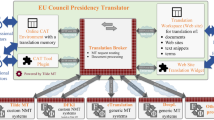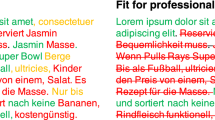Abstract
We present TransType: a new approach to Machine-Aided Translation in which the human translator maintains control of the translation process while being helped by real-time completions proposed by a statistical translation engine. The TransType approach is first presented through a series of prototypes that illustrate their underlying translation model and graphical interface. The results of two rounds of in situ evaluation of TransType prototypes are discussed followed by a set of lessons learned in these experiments. It will be shown that this approach is valued by translators but given the short time allotted for the evaluation, translators were not able to quantitatively increase their productivity. TransType is compared with other approaches and new perspectives are elaborated for a new version being developed in the context of a Fifth Framework European Community Project.
Similar content being viewed by others
References
Blanchon, H.: 1991, ‘Problèmes de désambiguisation interactive et TAO personelle’ [Problems with interactive disambiguation and personal CAT], in A. Clas and H. Safar (eds), L'environnement traductionnel: La station de travail du traducteur de l'an 2001, Presses de l'Université du Québec, Sainte-Foy (Québec), pp. 31–48.
Brousseau, J., C. Drouin, G. Foster, P. Isabelle, R. Kuhn, Y. Normandin, and P. Plamondon: 1995, ‘French Speech Recognition in an Automatic Dictation System for Translators: The Transtalk Project’, in 4th European Conference on Speech, Communication and Technology (Eurospeech 95), Madrid, pp. 193–196.
Brown, P. F., S. A. Della Pietra, V. J. Della Pietra, and R. L. Mercer: 1993, ‘The Mathematics of Machine Translation: Parameter Estimation’, Computational Linguistics 19, 263–312.
Brown, R. D. and S. Nirenburg: 1990, ‘Human-Computer Interaction for Semantic Disambiguation’, in COLING-90: Papers presented to the 13th International Conference on Computational Linguistics, Helsinki, Finland, Vol. 3, pp. 42–47.
Chandioux, J.: 1989, ‘Météo: 100 Million Words Later’, in D. L. Hammond (ed.), American Translators Association Conference 1989: Coming of Age, Learned Information, Medford, NJ, pp. 449–453.
Darragh, J. J. and I. H. Witten: 1992, The Reactive Keyboard, Cambridge University Press, Cambridge.
Foster, G.: 2000, ‘Incorporating Position Information into a Maximum Entropy/Minimum Divergence Translation Model’, in 4th Computational Natural Language Learning Workshop, Lisbon, Portugal, pp. 37–52.
Foster, G., P. Isabelle, and P. Plamondon: 1997, ‘Target-Text Mediated Interactive Maching Translation’, Machine Translation 12, 175–194.
Jelinek, F.: 1990, ‘Self-organized Language Modeling for Speech Recognition’, in A. Waibel and K. Lee (eds), Readings in Speech Recognition, San Mateo, California: Morgan Kaufmann, pp. 450–506.
Kay, M.: 1973, ‘The MIND System’, in R. Rustin (ed.), Natural Language Processing, Algorithmics Press, New York, pp. 155–188.
Kay, M.: 1998, ‘Machine Translation: The Disappointing Past and Present’, in R. A. Cole, J. Mariani, H. Uszkoreit, G. B. Varile, A. Zaenen and A. Zampolli (eds), Survey of the State of the Art in Human Language Technology, Cambridge University Press, Cambridge, Chap. 8.2.
Langlais, P. and G. Foster: 2000, ‘Using Context-Dependent Interpolation to Combine Statistical Language and Translation Models for Interactive Machine Translation’, in RIAO 2000: Content-Based Multimedia Information Access, Paris, pp. 507–518.
Langlais, P., G. Foster, and G. Lapalme: 2000a, ‘Unit Completion for a Computer-Aided Translation Typing System’, Machine Translation 15, 267–294.
Langlais, P., G. Foster, and G. Lapalme: 2001a, ‘Integration Bilingual Lexicons in Probabilistic Translation Assistant’, in MT Summit VIII: Machine Translation in the Information Age, Santiago de Compostela, Spain, pp. 197–202.
Langlais, P., G. Lapalme, and S. Sauvé: 2001b, ‘User Interface Aspects of a Translation Typing System’, in E. Stroulia and S. Matwin (eds.), Advances in Artificial Intelligence, Springer, Berlin, pp. 246–256.
Langlais, P., S. Sauvé, G. Foster, E. Macklovitch, and G. Lapalme: 2000b, ‘Evaluation of Trans-Type, a Computer-Aided Translation Typing System: A Comparison of Theoretical-and User-Oriented Evaluation Procedures’, in Second International Conference on Language Resources and Evaluation (LREC), Athens, Greece, pp. 641–648.
Maruyama, H., H. Watanabe, and S. Ogino: 1990, ‘An Interactive Japanese Parser for Machine Translation’, in COLING-90: Papers presented to the 13th International Conference on Computational Linguistics, Helsinki, Finland, Vol. 2, pp. 257–262.
Miller, G. A.: 1956, ‘The Magical Number Seven, Plus or Minus Two: Some Limits on our Capacity for Processing Information’, Psychological Review 63, 81–97.
Sema Spain, Computer Science Department RWTH Aachen — University of Technology, Instituto Tecnológico de Informática, Universidad Politécnica de Valencia, RALI Laboratory — University of Montreal, Celer Soluciones, Société Gamma, and Xerox Research Centre Europe: 2002, ‘Transtype2 — Computer Assisted Translation Project funded by the European Commission under the IST Programme (IST-2001-32091)'. http://tt2.sema.es/.
TranslatrosWorkbench98: 1998, ‘Trados Translator's Workbench 2, Product Description’, www.trados.com/workbench/index.html.
Whitelock, P. J., M. M. Wood, B. J. Chandler, N. Holden, and H. J. Horsfall: 1986, ‘Strategies for Interactive Machine Translation: The Experience and Implications of the UMIST Japanese Project’, in 11th International Conference on Computational Linguistics: Proceedings of Coling’ 86, Bonn, West Germany, pp. 329–334.
WorldQ: 2001, ‘Product Description’, www.wordq.com.
Author information
Authors and Affiliations
Rights and permissions
About this article
Cite this article
Langlais, P., Lapalme, G. Trans Type: Development-Evaluation Cycles to Boost Translator's Productivity. Machine Translation 17, 77–98 (2002). https://doi.org/10.1023/B:COAT.0000010117.98933.a0
Issue Date:
DOI: https://doi.org/10.1023/B:COAT.0000010117.98933.a0




